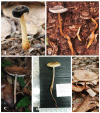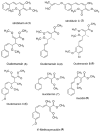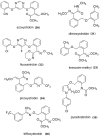Taxonomy, Diversity and Cultivation of the Oudemansielloid/Xeruloid Taxa Hymenopellis, Mucidula, Oudemansiella, and Xerula with Respect to Their Bioactivities: A Review
- PMID: 33451109
- PMCID: PMC7828609
- DOI: 10.3390/jof7010051
Taxonomy, Diversity and Cultivation of the Oudemansielloid/Xeruloid Taxa Hymenopellis, Mucidula, Oudemansiella, and Xerula with Respect to Their Bioactivities: A Review
Abstract
The oudemansielloid/xeruloid taxa Hymenopellis, Mucidula, Oudemansiella, and Xerula are genera of Basidiomycota that constitute an important resource of bioactive compounds. Numerous studies have shown antimicrobial, anti-oxidative, anti-cancer, anti-inflammatory and other bioactivities of their extracts. The bioactive principles can be divided into two major groups: (a) hydrophilic polysaccharides with relatively high molecular weights and (b) low molecular medium polar secondary metabolites, such as the antifungal strobilurins. In this review, we summarize the state of the art on biodiversity, cultivation of the fungi and bioactivities of their secondary metabolites and discuss future applications. Although the strobilurins are well-documented, with commercial applications as agrochemical fungicides, there are also other known compounds from this group that have not yet been well-studied. Polysaccharides, dihydro-citrinone phenol A acid, scalusamides, and acetylenic lactones such as xerulin, also have potential applications in the nutraceutical, pharmaceutical and medicinal market and should be further explored. Further studies are recommended to isolate high quality bioactive compounds and fully understand their modes of action. Given that only few species of oudemansielloid/xeruloid mushrooms have been explored for their production of secondary metabolites, these taxa represent unexplored sources of potentially useful and novel bioactive metabolites.
Keywords: Basidiomycota; bioactive compounds; cultivation; diversity; taxonomy.
Conflict of interest statement
The authors declare no conflict of interest.
Figures










Similar articles
-
A new species and new records of Hymenopellis and Xerula (Agaricales, Physalacriaceae) from China.PeerJ. 2023 Dec 20;11:e16681. doi: 10.7717/peerj.16681. eCollection 2023. PeerJ. 2023. PMID: 38144183 Free PMC article.
-
Introduction of two novel species of Hymenopellis (Agaricales, Physalacriaceae) from Thailand.MycoKeys. 2023 Jul 24;98:253-271. doi: 10.3897/mycokeys.98.104517. eCollection 2023. MycoKeys. 2023. PMID: 37534304 Free PMC article.
-
Submerged cultivation of medicinal mushrooms: bioprocesses and products (review).Int J Med Mushrooms. 2012;14(3):211-39. doi: 10.1615/intjmedmushr.v14.i3.10. Int J Med Mushrooms. 2012. PMID: 22577974 Review.
-
Macrofungi as a Nutraceutical Source: Promising Bioactive Compounds and Market Value.J Fungi (Basel). 2021 May 19;7(5):397. doi: 10.3390/jof7050397. J Fungi (Basel). 2021. PMID: 34069721 Free PMC article. Review.
-
Antibiotics from basidiomycetes. XVIII. Strobilurin C and oudemansin B, two new antifungal metabolites from Xerula species (Agaricales).J Antibiot (Tokyo). 1983 Jun;36(6):661-6. doi: 10.7164/antibiotics.36.661. J Antibiot (Tokyo). 1983. PMID: 6874589
Cited by
-
Genomic and Experimental Investigations of Auriscalpium and Strobilurus Fungi Reveal New Insights into Pinecone Decomposition.J Fungi (Basel). 2021 Aug 23;7(8):679. doi: 10.3390/jof7080679. J Fungi (Basel). 2021. PMID: 34436218 Free PMC article.
-
New Insights into Interactions between Mushroom Aegerolysins and Membrane Lipids.Toxins (Basel). 2024 Mar 9;16(3):143. doi: 10.3390/toxins16030143. Toxins (Basel). 2024. PMID: 38535809 Free PMC article.
-
Whole Genome Sequence of an Edible Mushroom Oudemansiella raphanipes (Changgengu).J Fungi (Basel). 2023 Feb 16;9(2):266. doi: 10.3390/jof9020266. J Fungi (Basel). 2023. PMID: 36836380 Free PMC article.
-
Metagenomic Analyses of the Soybean Root Mycobiome and Microbiome Reveal Signatures of the Healthy and Diseased Plants Affected by Taproot Decline.Microorganisms. 2022 Apr 21;10(5):856. doi: 10.3390/microorganisms10050856. Microorganisms. 2022. PMID: 35630301 Free PMC article.
-
Strobilurin X acts as an anticancer drug by inhibiting protein synthesis and suppressing mitochondrial respiratory chain activity.Discov Oncol. 2024 May 20;15(1):177. doi: 10.1007/s12672-024-01041-w. Discov Oncol. 2024. PMID: 38769217 Free PMC article.
References
-
- Zhang J.X., Chen Q., Huang C.Y., Gao W.Q.J. History, current situation and trend of edible mushroom industry development. Mycosystema. 2015;34:524–540.
-
- Hyde K.D., Xu J., Rapior S., Jeewon R., Lumyong S., Niego A.G.T., Abeywickrama P.D., Aluthmuhandiram J.V.S., Brahamanage R.S., Brooks S., et al. The amazing potential of fungi: 50 ways we can exploit fungi industrially. Fungal Divers. 2019;97:77–160. doi: 10.1007/s13225-019-00430-9. - DOI
-
- De Silva D.D., Rapior S., Fons F., Bahkali A.H., Hyde K.D. Medicinal mushrooms in supportive cancer therapies: An approach to anti-cancer effects and putative mechanisms of action. Fungal Divers. 2012;55:1–35. doi: 10.1007/s13225-012-0151-3. - DOI
-
- De Silva D.D., Rapior S., Hyde K.D., Bahkali A.H. Medicinal mushrooms in prevention and control of diabetes mellitus. Fungal Divers. 2012;56:1–29. doi: 10.1007/s13225-012-0187-4. - DOI
Publication types
Grants and funding
LinkOut - more resources
Full Text Sources
Other Literature Sources

